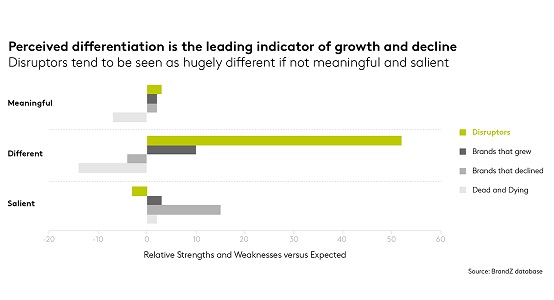
The high-profile bankruptcy of Toys R Us is the most recent in a long line of brands that failed to adapt to changing times. From a consumer perspective, habit and existing positive attitudes may keep the incumbent brand staggering on for a time but eventually people recognize they are missing out and go elsewhere.
It’s interesting that from a consumer perspective the same set of brand associations that identifies a dying brand also identifies a disruptive brand. The chart below shows the brand equity profile of disruptive and dead or dying brands as measured by BrandZ™. The disruptive brands include Tesla, Uber, Dollar Shave Club, Airbnb, Free, Netflix and Facebook. Among the dead and dying brands shown are Borders Bookstore, Blockbuster, Pontiac, Circuit City, Nokia and MySpace. Relative to their existing customer base, disruptive brands are far more likely to be seen as different from the competition – dead and dying brands less so.

The same is true of everyday, non-disruptor brands, but to a lesser degree. An examination of 2052 brands measured in BrandZ between 2014 and 2017 found that 6% grew significantly and 5% declined. On average, the brands that grew tend to be perceived as different, the brands that declined are weaker than expected. Note that the brands which decline tend to be more salient than expected but, unfortunately, being top of mind with the consumer in a buying situation doesn’t guarantee being chosen if better differentiated or cheaper alternatives are available. People do sometimes deliberate on their purchase decisions, particularly for more expensive or riskier choices. This is when a different and meaningful offer wins the day.
The origins differentiation might differ between the truly disruptive brands and the everyday. The disruptors rely on some form of functional advantage to make their product or service simpler, more convenient or cheaper which will ladder up to positive affinity for the brand. Everyday brands, particularly in established categories, may struggle to find a meaningful functional advantage, but purpose, design and marketing can still help a brand stand out from the crowd and make an emotional connection with its potential customers.
In marketing, it has become popular to dismiss the importance of perceived difference, but this analysis reminds us that when it comes to longer-term success differentiation is still important. Every marketer should be looking for ways to make their brand seem different so that it’s the obvious choice when people do deliberate on their purchase decision.
Authored by: Nigel Hollis, Chief Global Analyst, Kantar Millward Brown. Source Here.

